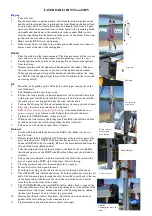
18 – VWR STandaRd Line PiPeTTORS
instruction Manual – 19
10. Pipettor Maintenance
depending on the applications and intensity of use,
the pipettor requires periodic maintenance. The com-
ponents exposed to corrosive vapors, such as shaft
elements, should be regularly checked and cleaned.
do not use sharp tools for pipettor maintenance.
it may cause damage to the device and affect
the user’s safety.
Cleaning
external surfaces of the pipettor such as the push-
button, ejector pushbutton, handgrip, shaft nut, and
adjustment knob may be cleaned using a cloth damp-
ened in isopropyl alcohol. The remaining parts removed
from the pipettor during pipettor disassembly may be
washed with distilled water or isopropyl alcohol.
NOTE
: Before using cleaning agents other than those
recommended by the manufacturer, check the compat-
ibility charts and consider chemical resistance of the
following plastics which form components of the pipet-
tor: PP, PC, POM, Pa, PPS, PVdF.
Sterilization
Sterilization using an autoclave
The pipettor can be sterilized in an autoclave at 121°C
for 20 minutes. Sterilization under other conditions may
cause damage to the pipettor. it is recommended to:
•
Unscrew the shaft nut slightly in the 2-1,000 µL pipet-
tors, and unscrew the shaft slightly in the 5,000 µL and
10,000 µL. after autoclaving these parts should be
screwed tight again.
•
Sterilize the pipettors using an autoclave with an
initial vacuum and drying cycle.
•
after sterilization, the pipettor should be dried and
cooled to room temperature.
•
The shaft of the 5,000 µL and 10,000 µL models
should be autoclaved without the filter.
Precision and accuracy should not alter if the pipet-
ting processes including autoclaving are carried out as
described in this manual. if a change in accuracy occurs,
it is recommended to:
•
Check the calibration of the pipettor after the first,
third, and fifth autoclaving cycles and then after every
10 autoclaving cycles.
Ultra Violet (UV) Sterilization
The pipettors are UV resistant. The distance from the
radiation source to the exposed element of the pipet-
tor should be at least 50 cm. Prolonged or intense UV
exposure can cause discoloration of pipettor parts but
does not affect its performance.
11. Troubleshooting
if a problem is encountered during pipettor operation,
use the following table to identify and eliminate the
fault following the instructions provided. Replacement of
parts should be required only occasionally and should
not be required with normal pipettor use.
Problem
Cause
Solution
droplets
of liquid
remain in
the pipet
tip.
The pipet tip is emptied
too fast.
decrease the speed
of pressing
the pipettor
pushbutton.
The pipet tip wettability
has increased due to
extensive use.
Replace the tip with
a new one.
droplets
of air
appear in
the liquid
aspirated
into the
pipet tip.
The pipet tip immersion
depth is too shallow.
immerse the tip
to the recommend-
ed depth according
to the instructions.
The pipet tip is incor-
rectly pressed onto the
pipettor shaft.
Press the pipettor
tip firmly onto the
pipettor.
The tip is damaged or
worn out due to exten-
sive use.
Replace the tip with
a new one.
The pipet-
tor
incorrectly
aspirates
the liquid
or the liquid
drops out
from the tip.
The pipettor tip is incor-
rectly pressed onto the
pipettor shaft.
Press the pipet
tip firmly onto the
pipettor.
The shaft surface is
damaged or contami-
nated at the sealing
site.
Clean the shaft
or replace it with
a new one.






























